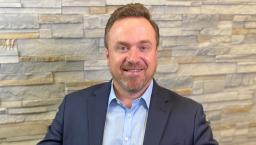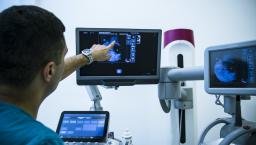What should come next after the public health emergency?

Christopher Johnson, president and co-CEO of TeleTracking
Photo: Christopher Johnson
The COVID-19 public health emergency officially ends on Thursday, May 11, and with it comes an array of policy and procedural changes nationwide. How should health IT leaders be thinking about the end of the PHE? After more than three years, what changes will this new era bring to hospitals and health systems? Might new platforms and strategies be needed? Are health system operations overdue for a check-up?
To answer these questions, Healthcare IT News sat down with Christopher Johnson, president and co-CEO of TeleTracking, which worked with the U.S. Department of Health and Human Services during the pandemic on key COVID-19 projects.
TeleTracking is a healthcare operations platform designed to expand the capacity to care by combining comprehensive technologies with clinical expertise to optimize access to care, streamline care delivery and connect transitions of care. It aims to provide interoperability between acute, nonacute, affiliated and nonaffiliated facilities.
Q. How should healthcare provider organization health IT leaders be approaching the May 11 end of the COVID-19 public health emergency?
A. The end of the PHE represents a significant psychological inflection point between simply keeping our heads above water and being able to focus on the future. I think health systems have an opportunity to leverage the vast talent available in the technology space to become innovators, not simply consumers of technology.
Health systems have long stifled innovations not directly related to the EHR, and as a result have inadvertently built a closed ecosystem that limits their ability to extend beyond their own facilities.
As healthcare delivery becomes increasingly fractured, what they need to focus on now is developing true operational interoperability that makes it possible to extend visibility in real time, not just across the enterprise, but across the market.
Q. What changes will the end of the public health emergency bring to hospitals and health systems across the U.S.?
A. COVID-19 and the ensuing PHE have done more to transform healthcare than any event or initiative in our lifetime. I truly believe the efforts made under this emergency declaration proved the power of the public and private sectors coming together in times of crisis to develop "sight" to what had been a "blind" system of disconnected facilities and providers.
Health systems need to reflect on the progress made to create national visibility to hospital capacity and preparedness, something previously unthinkable before the pandemic, and ensure that winding down the PHE does not mean they lose the progress that’s been made.
Now is the time to reimagine healthcare to create true interoperable visibility to operations in and beyond the four walls of the health system. With a relatively small investment, I think we as an industry can capture the wasted energy in the system and redeploy it to the benefit of not just the hospitals, but also the caregivers, and, most important, the patients.
It was, and continues to be, my opinion that the original scope of the PHE, specific to COVID-19, was too narrow and should in fact expand beyond the current pandemic. Limiting data collection and insights to this pandemic falls short of what we need as a nation.
Q. In partnership with HHS, your company worked with federal, state and local governments, and hospitals across the country to collect patient data, playing an important role in the nation’s response to the pandemic. From this experience you learned that, in your opinion, the nation needs an "All Hazards" platform. Please elaborate.
A. TeleTracking’s partnership with the U.S. Department of Health and Human Services showed the value in centralizing important capacity metrics across America’s more than 6,000 hospitals, 3,000 therapeutic sites, as well as local and state agencies. The work done during COVID-19 highlighted the need to expand beyond the latest pandemic to create a sustainable “All Hazards” platform.
The data collected as a result of these efforts, including more than one million distinct data points, played a critical role in the allocation of funding, equipment, vaccines, therapeutics and staff in response to the pandemic.
However, limiting this data to the pandemic is short sighted. For one, I believe we’ll unfortunately see the next pandemic, not 100 years from now, but within the next 10 years, and retreating now will, in history, be seen as a lost opportunity to continue building on the progress made.
The concept of an “All Hazards” platform takes what we’ve learned about the value of national data preparedness and applies it to local, state and federal agencies to ensure we, as a nation, are ready in times of natural disasters, health emergencies, terrorism or other widespread events.
Q. You say health system operations are overdue for a check-up and that the organizations need to adopt the idea of "Boundaryless Healthcare." Please describe what you mean.
A. It’s no secret that health systems are facing historic staffing shortages, challenges managing growing capacity, and unsustainable financial pressures forcing them to find new ways of improving operational management using communication, automation and data to start connecting their disconnected care settings.
With the shift from individual, independent hospitals to health systems came increased need for system-wide visibility to capacity, centralized placement capabilities, and the ability to visualize demand across the entire enterprise. Now, as they move beyond the health system to true market networks, the need for that visibility and data to scale across disparate health information systems, especially EHRs, has only increased.
Having operational interoperability across owned, affiliated and nonaffiliated care entities – including acute, ambulatory, post-acute, home health and more – fosters expanded partnerships and relational growth opportunities, creating a true healthcare ecosystem.
This means thinking not just about the patients’ acute care stay and the bed they occupy, but how they interact with the system throughout their entire care journey. By creating shared visibility into capacity, health systems can maintain and grow market share and “flatten the care continuum,” a practice that creates seamless transitions between stages of care.
To accomplish this, they’re moving beyond traditional bed management and adopting "Boundaryless Healthcare" – an operating model that allows them to look beyond the four walls of their health system by creating shared situational awareness of capacity, referral patterns and patient demand.
Boundaryless Healthcare plays a key role in improving visibility between facilities and care settings by helping each location understand where patients come from and where they are going, improving operations, workflow and communication.
This reimagining of healthcare operations, with true data interoperability, means providers are able to expand the capacity to care by optimizing access to care, streamlining care delivery and connecting transitions of care.
Follow Bill's HIT coverage on LinkedIn: Bill Siwicki
Email the writer: bsiwicki@himss.org
Healthcare IT News is a HIMSS Media publication.

098e.jpg)






















